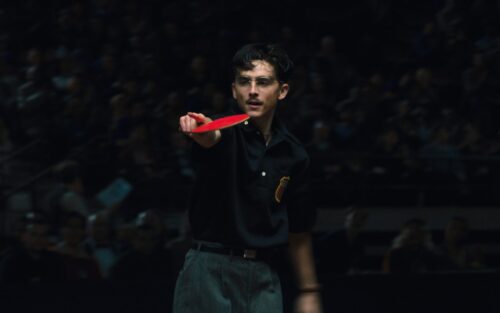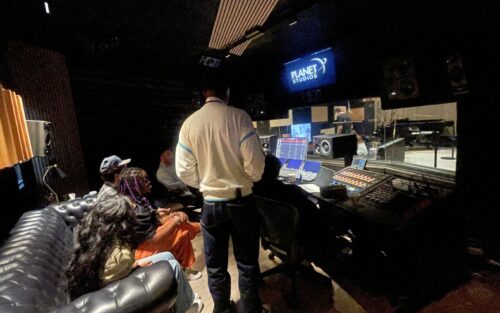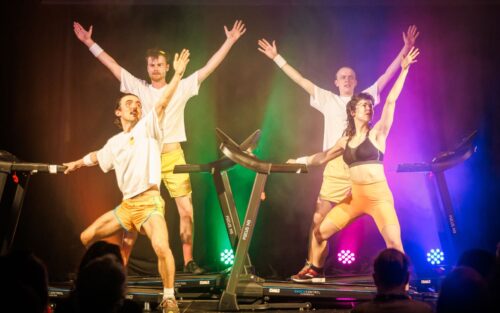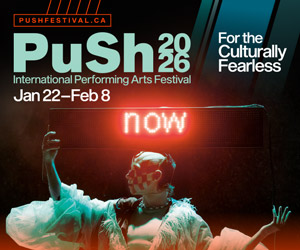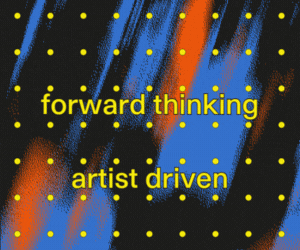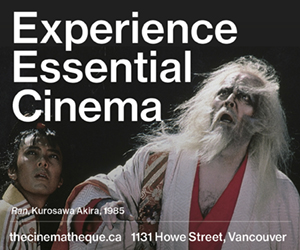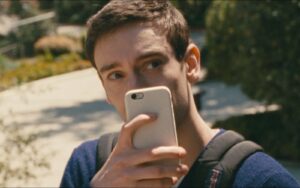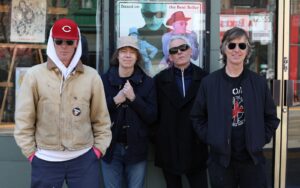
VIFF Live is Pushing the Boundaries of Cinema
Guest curator Norman Armour introduces his cutting edge programming and a Q&A with centrepiece artist Software2050.
by Maggie McPhee
- Published on
For the first time in its history, the Vancouver International Film Festival has welcomed someone from outside the organization to curate VIFF Live. Norman Armour, who dreamt of working for a film festival all his life, could not be more ecstatic. “I’ve been a huge fan of the film festival and what it programs, what it stands for and the audience that it has,” he tells RANGE.
Armour, who co-founded and directed the PuSh International Performing Arts Festival, has decades of experience operating at the cutting edge of interdisciplinary art. VIFF Live describes its showcase as “performances that push the boundaries of traditional film festival programming, intersecting cinema culture with music, comedy, podcasting, and performance in unique, cinema-infused live shows.”
Armour has sharpened his curatorial eye not only as a festival consultant and programmer but as an artist himself. His theatrical work incorporates dance, film, and music composition. “That’s always been a kind of running theme through my career,” he says, “an interest in multiple art forms and the combination of them.”
VIFF continues to update its slate of cinema-adjacent works to reflect our current historical moment, its accompanying technologies, and its divergent stakeholders. Armour is poised to inch that progress further towards the future.
“If the festival is looking to continue to evolve and expand its notion of the work that it presents and the artist presents,” he says, “then this is my contribution to that conversation.”
In addition to two centrepiece programs, 32 Sounds and Machine Folklore, Armour has developed a residency program for a handful of artists to embed themselves within the festival. Archivist Daniel Barrow, cellist Cris Derksen, animator Miwa Matreyek, and digital performance artist Sammy Chien will bring their unique mediums to the historic Iron Works performance space.
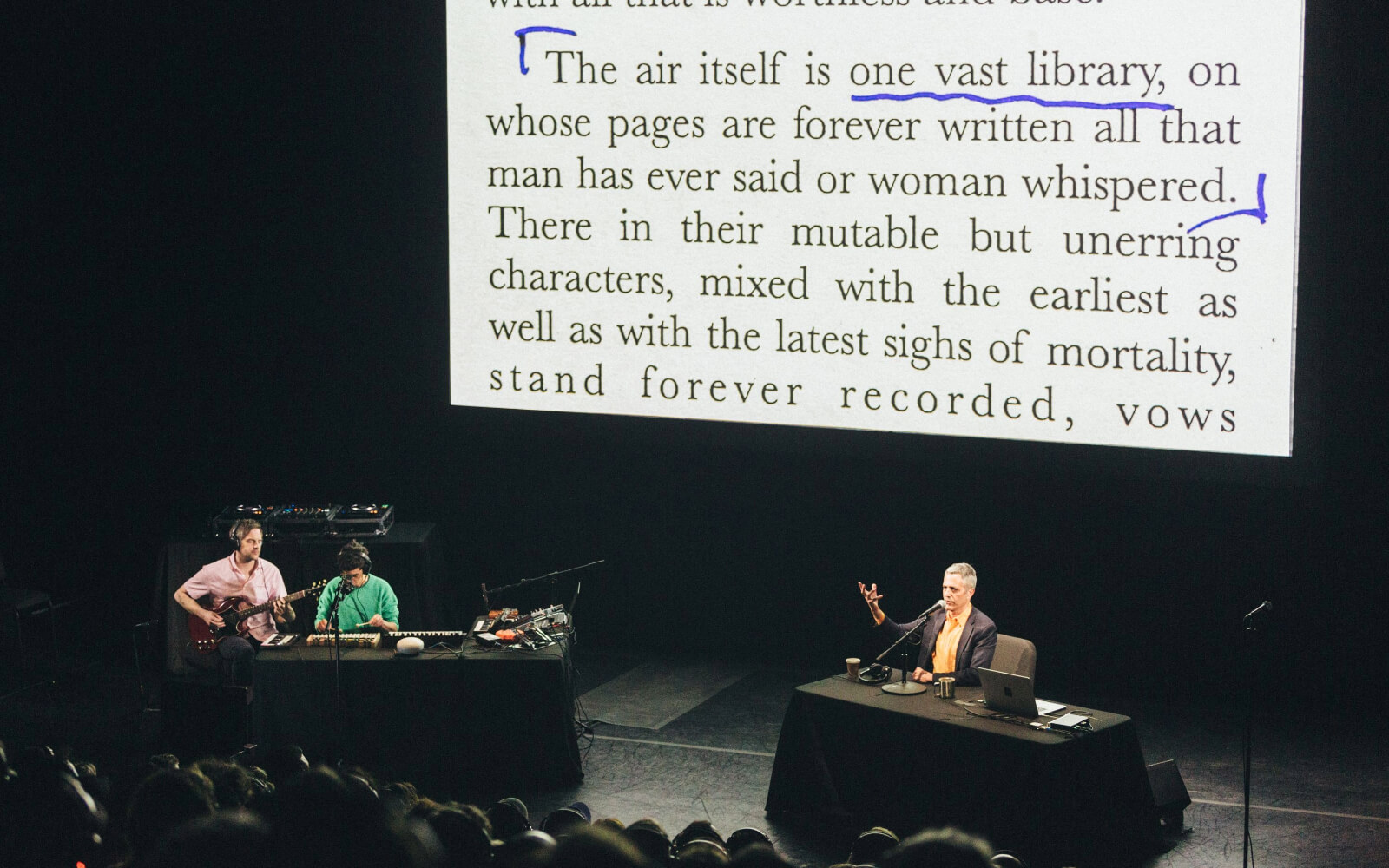
Sam Green: 32 Sounds
What Armour admires most about VIFF? The people who fill Vancouver’s theatres every fall. “That audience is so open-minded, so discerning but not judgmental,” he says. “They’re curious and they’re excited, they’re interested in other worlds and other perspectives.”
In all likelihood Armour’s selections will meet that audience at their level. “I really hope that the work gets under their skin,” he shares, “in a way that challenges them to the degree that it lives on with them after they’ve left the cinema.”
One such offering hails from Taiwan’s foremost art collective NAXS FUTURE. Their immersive audio-visual performance Machine Folklore merges AI, digital art, and improvisational soundscapes. “Five years ago, I would have said they were the next generation, but they are the generation,” says Armour.
Machine Folklore is a piece that defies explanation. Luckily Han-Yu Feng — who releases art under the pseudonym Software2050 and directs NAXS FUTURE — can tell you in his own words. Feng and the team of new media artists, designers, and engineers at NAXS FUTURE use VR, immersive theatre, online exhibitions, and audiovisual performance to develop experimental new media works.
How and why did Software2050 and NAXS FUTURE partner for this project?
The Machine Folklore project is initiated by me personally. I’ve invited other members of the NAXS team to join in its production because I envision this project as a realisation of immersive theatre-inspired audiovisual performances and exhibitions. The NAXS team is assisting with integrating game engine technology, designing AI-driven visuals, and planning the theatrical lighting atmosphere. My primary responsibilities lie in conceptualizing and artistically coordinating the overall project, handling some aspects of visual design, and composing the music.
What are the themes, ideas, and materials that have motivated your artistic practice? What led you to where you are now, to this project?
Software2050 focuses on the theme of “non-human,” attempting to capture the perspective and senses of an “AI” or some form of future, novel life through abstract visuals and sound. It also seeks to interpret the delicate relationship between future life and the human species, oscillating between inheritance and renewal, through the lens of folklore.
Themes such as technology, civilization, artefacts, species, and poetry are frequently on my radar. I enjoy traversing between the realms of the new and the old, searching for clues that connect the two ends of time. My creative work often has a lower degree of personal connection, as I prefer not to showcase myself but rather immerse myself in another character’s role, thinking and crafting narratives from their perspective.
In the collaborative team projects at NAXS, we often employ a “ritualistic” approach, which involves audience participation, making the audience an integral part of the artwork, and sometimes the work becomes complete through their involvement. This ritualistic approach also encompasses sensory aspects, manipulating visual, auditory, and spatial perception to trigger primal sensations within the audience’s core, ultimately forming “images.”
What was the inspiration behind the project? How did the process of making it inform what it was to become?
This work draws its inspiration from my fascination with the concept of AI or future life forms. I enjoy contemplating a future world that goes beyond the boundaries of human imagination. However, I approach this exploration not in a cold, purely technological manner, but by imbuing it with “emotion” and “perception.” I develop the creative work from the perspective of “it” – the entity in question, allowing its viewpoint to shape the narrative.
What is the creative process behind what you do?
My creative approach involves the intertwining of “narrative” and “sensory” elements. While developing music and visuals, I typically begin by constructing a foundational narrative. This narrative has a general sense of direction, with fragmented character settings, timeline arrangements, and event designs. Although it doesn’t constitute a complete story, it serves as a vital starting point for my audiovisual creations. It influences the spatial aspects of visual scenes, the emotions conveyed through the music, and the overall structure of the work.
As the work gradually takes shape, I become more focused on the presentation of “sensory” elements. This entails how images, sounds, or lighting are orchestrated to evoke emotions in the audience and provide them with specific perceptual experiences.
Upon completion of the work, the narrative often takes a step back, allowing the audience to interpret and immerse themselves in the essence of the piece in their own unique ways.
In my music composition, I employ various sampling techniques, including environmental sounds I record in my daily life and random materials collected from the internet. I frequently use Granular synthesis, which involves slicing sounds into countless tiny fragments and generating sound by striking these fragments with numerous minuscule particles. While the sampled sound materials are “human,” the use of Granular synthesis interprets them in a “non-human” manner, almost like an unknown language of a new species.
Regarding visual design, some portions of the imagery are generated by NAXS team member “eg.lio”, who excels in writing deconstructive-style poetry. AI processes these poetic verses to compute dynamic visuals. In a way, the visuals are co-created by us in collaboration with AI.
How does Machine Folklore relate to cinema? Are you interested in expanding what people think of as cinema? Or is this something entirely different?
I have been deeply influenced by films, but what often lingers in my mind is not the story itself but rather the “images.” For example, the enigmatic black monolith drifting in space in “2001: A Space Odyssey” and its symbolism of “evolution,” or Tarkovsky’s poetic long takes.
The audiovisual work “Machine Folklore” is conceived with a cinematic, or theatrical perspective in mind. The musical segments contain “narrative” elements as well as “material” ones. When I refer to material sounds, it’s akin to a documentary approach. It leads the audience into a specific environment, observing, collecting, and presenting the elements within it from an objective standpoint. At this point, it’s more about soundscapes than traditional music.
Regarding visuals, while the imagery follows a narrative along with the music, we enjoy disrupting the presence of “humans” in various ways. For instance, we use Orthographic projection to capture space, or employ vibrant and intricate colours to distort the typical visual perception of the human eye.
We are keen on pushing the boundaries of cinema, but as for whether “Machine Folklore” can be classified as an extension of cinema, I believe that interpretation ultimately lies with the audience rather than ourselves.
How do you hope audiences will engage with the work? How will the work engage with audiences?
We hope that the audience can immerse themselves in our work much like they do when watching a movie. However, it’s not just about watching; it also includes listening and being aware of the spatial and lighting aspects of the environment beyond the screen. It would be wonderful if the audience could envision an non-existent world and freely navigate within it.
In all our works, we tend to enjoy bringing the audience together in some way in the end, creating a collective experience.
What are you most excited about in regards to this specific work?
Breaking the boundaries of identity across languages, connecting with strangers in different spaces through sound, imagery, and lighting.
Is there anything else you would like to share?
The fact that this audiovisual work is being showcased at a film festival, typically associated with music or digital art festivals, is exceptionally special and exciting for us.
The Vancouver International Film Festival runs September 28 through October 8 | TICKETS & INFO
By Glenn Alderson
A deep-listening session reveals how Apple Music’s sonic innovation reshapes the way we hear.
By Cam Delisle
Dominic Weintraub and Hugo Williams take audiences on a treadmill-fueled ride through the chaos and hope of modern life.

